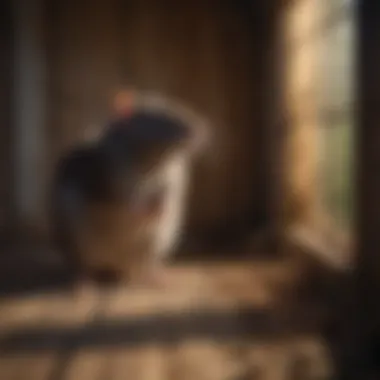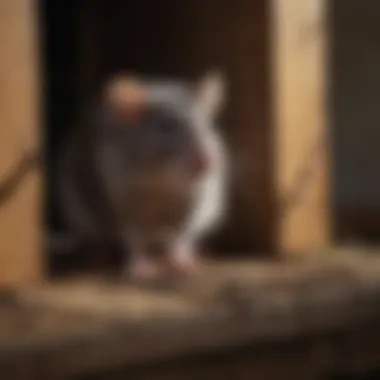Effective Strategies for Removing Rats From Your Shed


Preventive Pest Control Strategies
When starting your journey to eliminate rats from your shed, you must begin by implementing robust preventive pest control strategies. This involves a multi-faceted approach to fortify your household against potential rodent invasions. Firstly, focus on protecting the exterior of your house. Take time to inspect and seal any visible cracks that may serve as entry points for unwelcome pests. Additionally, ensure that debris is cleared regularly to eliminate potential hiding spots for rodents. By preventing pests from entering your home, you create a strong first line of defense against rat infestations. Moving on to yard maintenance, it is crucial to adhere to essential routines that keep your yard free from pests. Employ methods such as trimming vegetation, removing standing water, and mowing the lawn regularly to deter rats from taking residence in your outdoor space. Furthermore, maintaining indoor cleanliness is paramount for pest control. Incorporate expert cleaning tips and techniques to create a pest-resistant environment inside your home. By eliminating potential food sources and nesting areas, you can significantly reduce the attractiveness of your house to rodents. Proper garbage disposal is another key element in pest prevention. Explore efficient waste disposal methods to curb rodent activity around your shed. Emphasize the importance of correct garbage disposal in deterring rats from lingering near your home. Lastly, consider other innovative pest prevention strategies that can further safeguard your residence from unwanted intruders.
Identifying Pest Risk Areas
After establishing preventive measures, the next step in your rat elimination journey is to identify pest risk areas in and around your shed. Begin by conducting thorough inspections of moisture-prone areas. Identify damp conditions that may attract rodents and implement suitable measures to prevent infestations. Additionally, focus on inspecting cracks and crevices, as these serve as common entry points for pests. Learn the importance of sealing these access points to thwart rodent intrusions. Greenery inspections are also essential in assessing pest risks. Understand how vegetation can impact pest activity and follow guidelines to maintain a yard that is unattractive to rats. Moreover, don't overlook other potential pest risk areas. Identify miscellaneous spots around your property that may harbor pests and take proactive measures to address these vulnerabilities.
Effective Pest Control Methods
With a solid foundation of preventative strategies and risk assessments, you can now delve into effective pest control methods to tackle rat infestations in your shed. Explore the utilization of natural repellents for pest control. Discover safe and effective solutions using essential oils, herbs, and plants to deter rodents from your premises. Additionally, consider chemical sprays as a viable option for eradicating pests. Learn how to safely use professional sprays while effectively eliminating rats from your environment. Pest traps are another valuable tool for pest control. Set up and utilize traps to capture and remove rodents safely from your shed. Furthermore, explore biological control methods that leverage natural predators to manage pest populations. Embrace environmental-friendly techniques that promote a harmonious balance between pest control and ecosystem preservation. Finally, explore other innovative pest control methods beyond traditional approaches to discover effective strategies in combating rodent infestations.
Pest Species Identification
As you progress in your rat elimination journey, understanding the various pest species is crucial. Familiarize yourself with common insects that may invade your home and learn how to manage infestations effectively. Identify rodent species, including mice and rats, and implement measures to prevent their invasion. Address problematic bird species that can impact your residential area and explore ways to mitigate bird-related issues. Develop strategies for dealing with wildlife encounters on your property, including understanding wildlife behavior and utilizing control measures when necessary. Lastly, focus on identifying miscellaneous pest species that may pose a threat and learn how to manage them effectively.
DIY Pest Control Techniques
Equipped with knowledge about pest species and control methods, you can now explore DIY pest control techniques to further enhance your rat elimination efforts. Discover homemade pest control solutions that are eco-friendly and easy to implement. Utilize essential oils for pest control to repel insects and rodents naturally. Implement effective pest traps and barriers to control and prevent infestations effectively. Explore top reputable pest control brands that offer reliable products for home pest management. Lastly, delve into miscellaneous DIY pest control techniques that provide unique solutions for various pest issues in your shed. By integrating these DIY approaches, you can augment your pest control arsenal and enjoy a rat-free environment in your shed.
Preventive Measures
Preventive measures are crucial when dealing with rat infestations in your shed. By implementing these strategies, you can safeguard your property against these destructive pests. Ensuring that rodents cannot enter your shed in the first place significantly reduces the risks associated with infestations. Securing entry points is paramount in rat prevention. It involves sealing cracks and gaps, installing door sweeps, and covering vents with mesh to block any potential entry for rats. Maintaining cleanliness also plays a key role in preventing rats from being attracted to your shed. Proper waste management, removing clutter, and storing food in airtight containers are all essential steps to deter these pests. By following these preventive measures diligently, you can create an environment that is highly unattractive to rats.
Securing Entry Points


Securing entry points is a critical aspect of rat prevention. One key element of this is Sealing Cracks and Gaps. By sealing off any openings in your shed, you can effectively block rat entry and minimize the chances of infestation. Sealing cracks and gaps is a popular choice due to its simplicity and effectiveness in keeping rodents out. The unique feature of this method lies in its ability to deny rats easy access points, thus forcing them to look for alternative locations. Although time-consuming, the advantages of sealing cracks and gaps far outweigh any disadvantages, making it an indispensable step in rat prevention. Installing Door Sweeps is another essential component of securing entry points. By fitting door sweeps at the base of doors, you create a barrier that prevents rats from sneaking in through gaps. The key characteristic of door sweeps is their ability to block out rodents effectively. This method is beneficial as it offers a straightforward yet highly efficient solution for keeping rats at bay. The unique feature of door sweeps is that they provide a physical barrier that rats struggle to bypass, making it a reliable choice for rat prevention. While door sweeps may require initial installation effort, their advantages in rat prevention are undeniable. Covering vents with mesh is a vital step in securing entry points. By using wire mesh to cover vents, you restrict rat access while still allowing proper ventilation. The key characteristic of this method is its ability to create a barrier without compromising airflow. Covering vents with mesh is a popular choice due to its dual functionality of pest exclusion and ventilation maintenance. The unique feature of this method lies in its versatility, as it can be applied to various types of vents with ease. Despite the additional effort required for installation, the advantages of using mesh to cover vents for rat prevention are substantial.
Maintaining Cleanliness
In addition to securing entry points, maintaining cleanliness is essential in deterring rats from your shed. Proper waste management is a cornerstone of rat prevention. By disposing of waste correctly and promptly, you eliminate potential food sources that attract rats. The key characteristic of proper waste management is its role in removing rat-attracting odors and substances from your property. This method is popular due to its effectiveness in making the environment less appealing to rodents. The unique feature of proper waste management is its ability to address the root cause of rat infestations by cutting off their food supply. While it may require consistent effort, the advantages of proper waste management in rat prevention are significant. Removing clutter from your shed is another crucial aspect of maintaining cleanliness. By decluttering your space, you remove hiding spots and nesting areas for rats. The key characteristic of removing clutter is its impact on reducing potential shelter for rodents. This method is beneficial as it disrupts the living conditions that rats seek in sheds. The unique feature of decluttering lies in its ability to create a less hospitable environment for rats, making your shed an unattractive habitat for these pests. While it may involve initial time investment, the advantages of removing clutter for rat prevention are noteworthy. Lastly, storing food in airtight containers is paramount for maintaining cleanliness and deterring rats. By sealing food items in airtight containers, you eliminate feeding opportunities for rodents. The key characteristic of storing food in airtight containers is its ability to prevent food odors from attracting rats. This method is popular for its simplicity and effectiveness in safeguarding your food supplies. The unique feature of airtight food storage is its capability to deny rats access to food, forcing them to search elsewhere for sustenance. While it may require diligence to ensure containers are always sealed, the advantages of storing food in airtight containers for rat prevention are undeniable.
Humane Trapping Methods
In this section, we delve into the crucial aspect of humane trapping methods and their significance in effectively addressing rat infestations in your shed. Humane trapping methods uphold ethical standards and aim to capture rats without causing harm. By opting for humane traps, you prioritize the well-being of the animals while still achieving your goal of rat removal.
Best Practices for Rat Trapping
Choosing the Right Trap Type
When selecting the appropriate trap type for rat trapping, consider factors like size, material, and mechanism. Live traps are often favored for their effectiveness in capturing rats alive. Their humane nature aligns with the core principles of this article, ensuring the safe confinement of pests without inflicting harm. Choose a trap that is sturdy, reliable, and suits the size of the targeted rodents, enhancing the success of your trapping efforts.
Placement of Traps
Strategic trap placement is key to successful rat trapping. Position traps along rat runways, near entry points, and areas with high rodent activity. Placing traps close to walls or hidden corners increases the likelihood of rats encountering them. Ensure traps are out of reach of children and pets while remaining easily accessible for monitoring and disposal, optimizing the efficiency of your trapping endeavor.
Baiting Strategies
Effective baiting plays a crucial role in attracting rats towards traps. Utilize baits like peanut butter, chocolate, or dried fruit to entice rats into entering the trap. Place bait at the entrance and trigger of the trap, ensuring rats are lured inside. Regularly check and replenish bait to maintain its freshness and appeal, increasing the chances of successful captures. Adopting a varied baiting strategy can help in enticing different rat species, enhancing the overall trapping efficacy.
Checking and Disposing of Trapped Rats


In this segment, we focus on the vital steps of checking and disposing of trapped rats after successful captures. Proper procedures post-trapping are essential to ensure hygienic practices and prevent potential health risks.
Regular Monitoring
Regularly inspect traps to monitor for captured rats. Check traps multiple times a day to promptly address any trapped rodents. Timely removal minimizes stress on captured rats and reduces the risk of escape or unnecessary suffering. Monitoring traps consistently enhances the efficiency of your trapping method, promoting a swift and competent rat removal process.
Safe Release Practices
When releasing trapped rats, prioritize safety precautions to safeguard both the animals and yourself. Choose a suitable release location away from residential areas to prevent rats from returning to your shed. Wear gloves during release and avoid direct contact with rodents to minimize exposure to possible diseases. By following safe release practices, you contribute to the ethical and humane treatment of captured rats, upholding respect for wildlife and ecosystem balance.
Hygienic Cleaning
After disposing of trapped rats, conduct thorough cleaning and sanitization of trap areas. Use disinfectants to eliminate any lingering odors or traces of rat activity, preventing attraction for new rodents. Maintain a clean and hygienic environment in and around the shed to deter future infestations. Implementing hygienic cleaning practices not only ensures a rat-free space but also promotes overall health and well-being for you and your household.
Professional Extermination Options
Professional extermination options play a crucial role in effectively addressing rat infestations in sheds. When preventive measures and humane trapping methods fall short, seeking professional help becomes necessary. Pest control experts bring a wealth of experience and specialized knowledge to tackle persistent infestations, large rat populations, and safety concerns that can pose risks to property and health. Their intervention is particularly vital when DIY attempts have failed or when the infestation is beyond the homeowner's capacity to handle.
When to Consider Professional Help
- Persistent Infestations
Persistent Infestations
Persistent rat infestations indicate a severe and ongoing problem that requires immediate attention. These infestations are characterized by rats repeatedly entering the shed despite attempts to deter them. Professional exterminators can properly assess the extent of the infestation, identify entry points, and implement effective measures to eradicate the rats permanently. While DIY methods may provide temporary relief, persistent infestations warrant the expertise and resources that professional services offer.


- Large Rat Populations
Large Rat Populations
A large rat population in and around the shed signifies a complex infestation that demands expert intervention. Professional pest control services are equipped to handle mass rat extermination effectively and efficiently. Dealing with a high number of rats on your own can be overwhelming and impractical. Pest control professionals utilize targeted strategies and advanced techniques to reduce rat numbers swiftly and prevent future reinfestations.
- Safety Concerns
Safety Concerns
Safety concerns related to rat infestations encompass health risks, property damage, and the use of hazardous pest control products. Rats carry diseases, contaminate food, and damage structures, posing significant risks to residents. Pest control experts prioritize safety protocols to protect both individuals and the environment during extermination processes. They employ eco-friendly practices, adhere to regulations, and ensure that all procedures are carried out responsibly to mitigate any potential harm.
Selecting a Reputable Pest Control Service
Choosing a reputable pest control service is essential to achieve effective and lasting results in rat elimination. Several key factors should be considered when selecting a service provider:
- Certifications and Licenses
Certifications and Licenses
Verification of the company's certifications and licenses guarantees that they meet industry standards and possess the necessary expertise to handle pest control operations. Licensed professionals are trained in the safe application of treatments and follow prescribed protocols for humane pest removal. Certifications demonstrate a commitment to quality service and adherence to best practices in pest management.
- Treatment Approaches
Treatment Approaches
Different pest control companies may offer various treatment approaches tailored to specific infestation types and severity levels. It is crucial to opt for a service provider that utilizes safe, effective, and environmentally friendly methods to eliminate rats from sheds. Understanding the treatment process and its implications is vital in ensuring that the chosen approach aligns with both the homeowner's preferences and the desired outcomes for rat eradication.
- Follow-Up Procedures
Follow-Up Procedures
Post-extermination activities and follow-up procedures are essential in rat control to prevent reinfestations and monitor the effectiveness of the treatment. Reputable pest control services outline clear follow-up protocols to assess the success of the extermination, address any residual issues, and provide recommendations for long-term prevention. Regular follow-ups can help maintain a rat-free environment and address any emerging pest concerns promptly.



